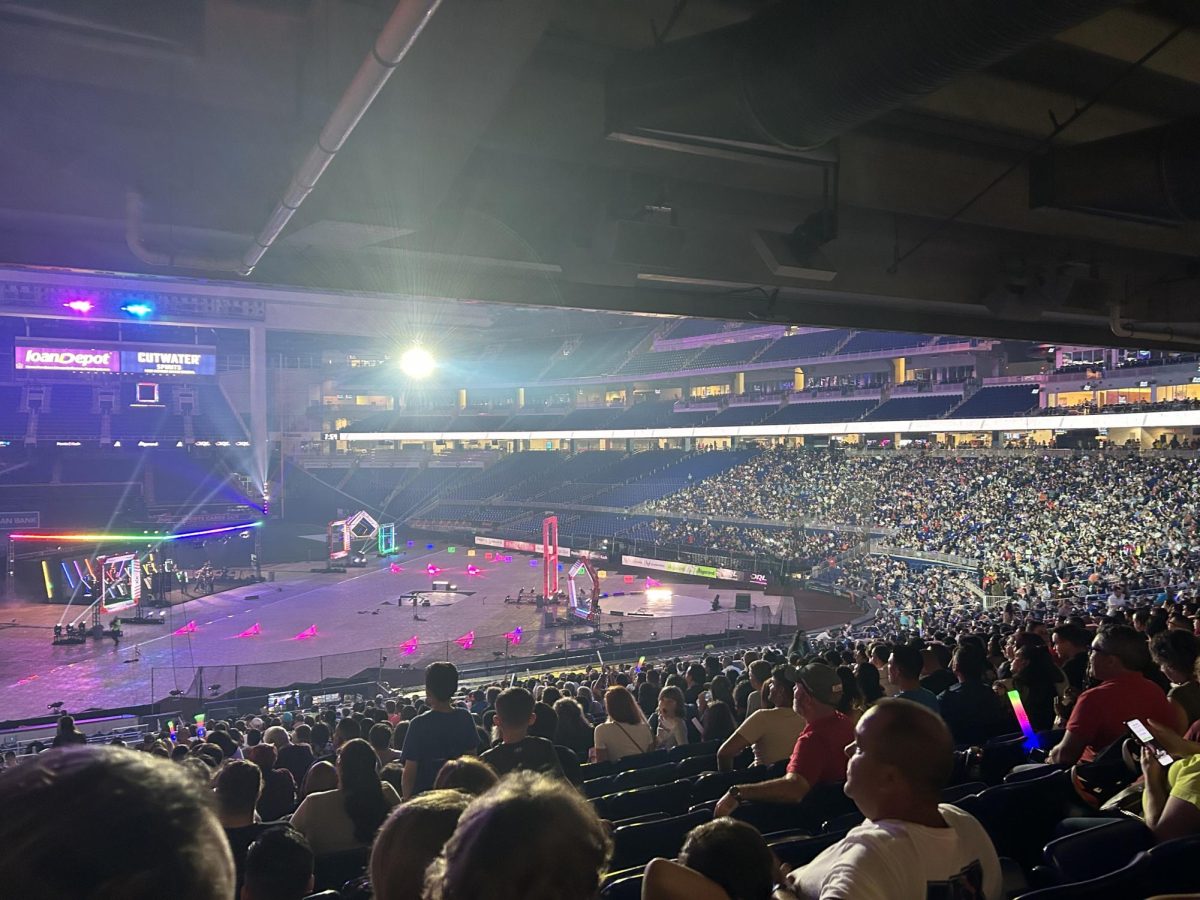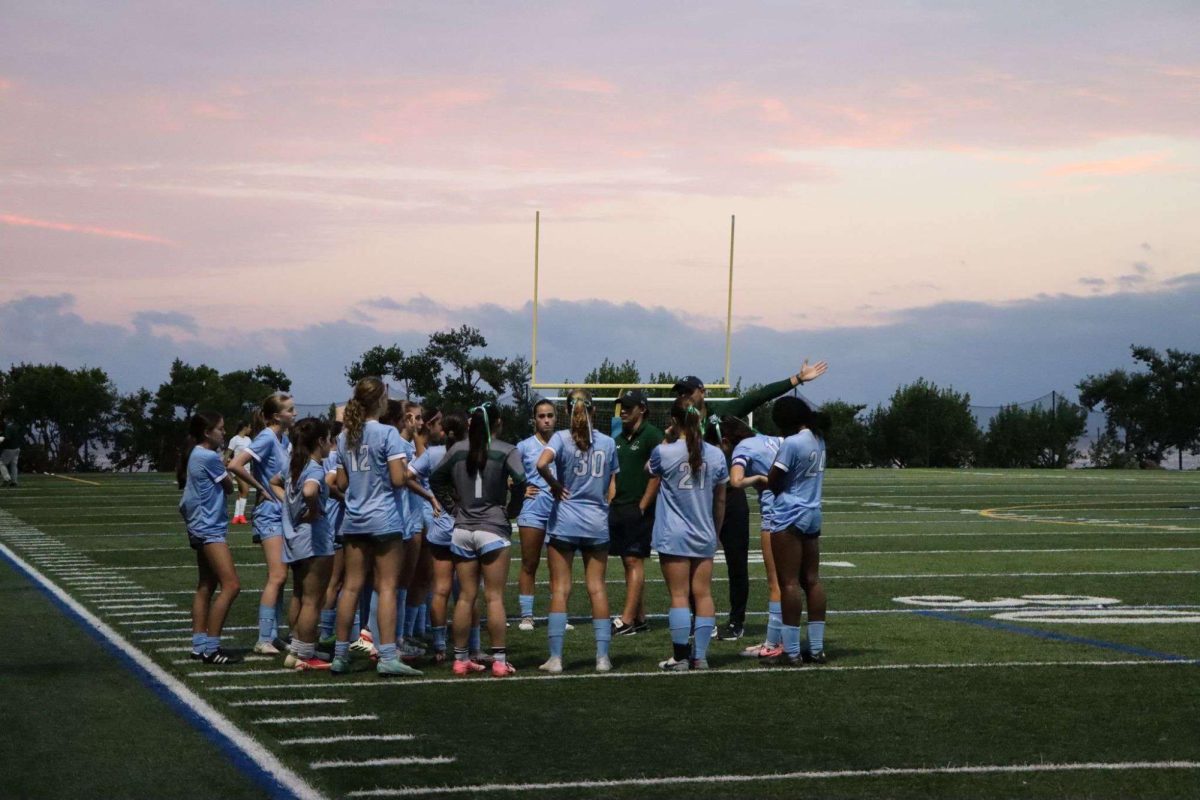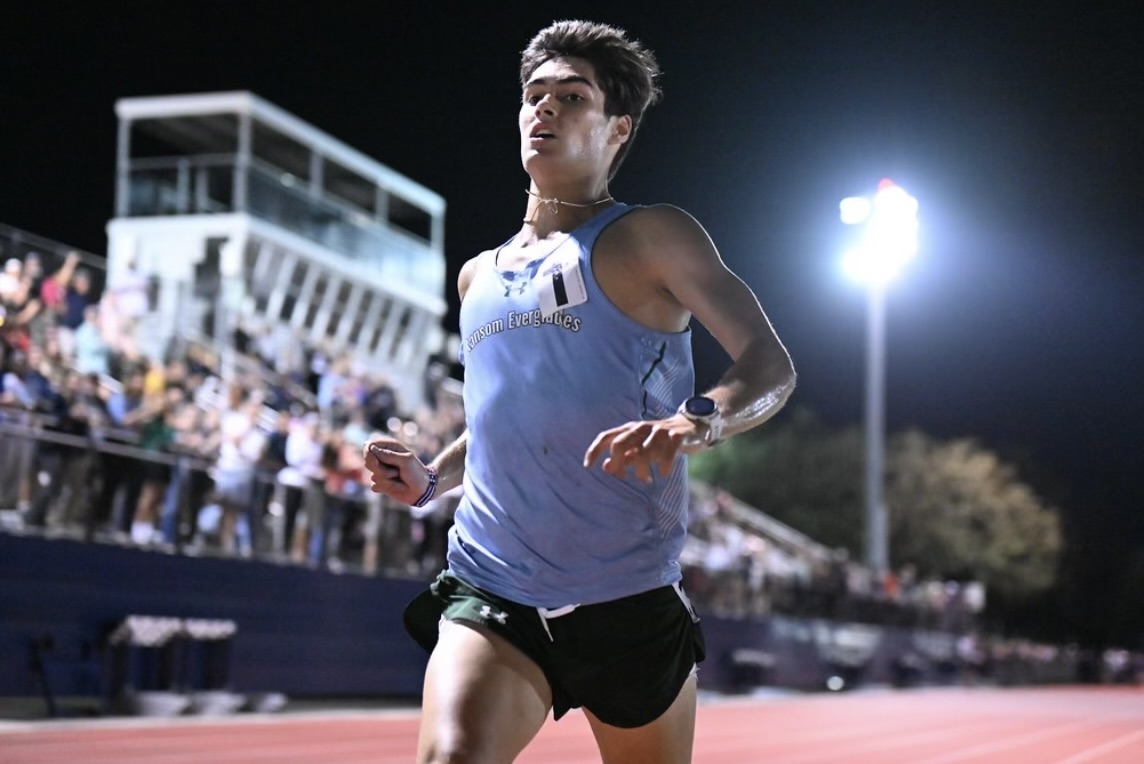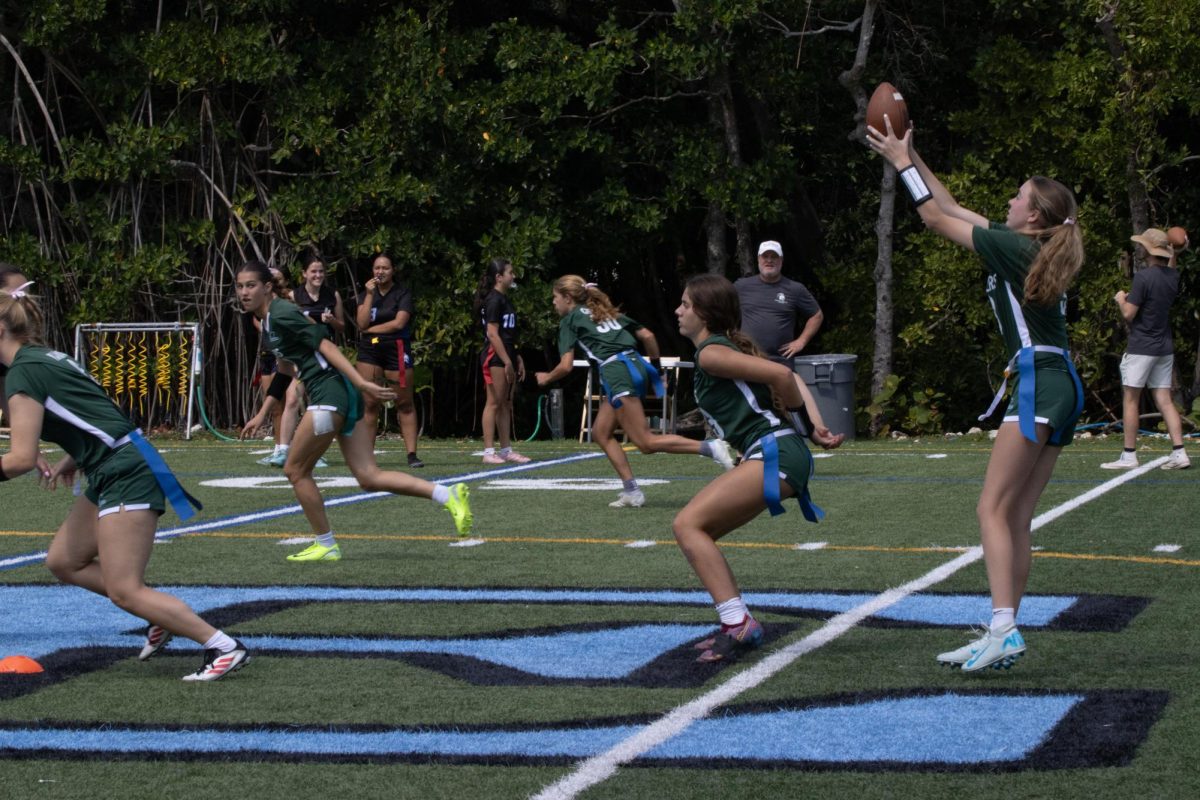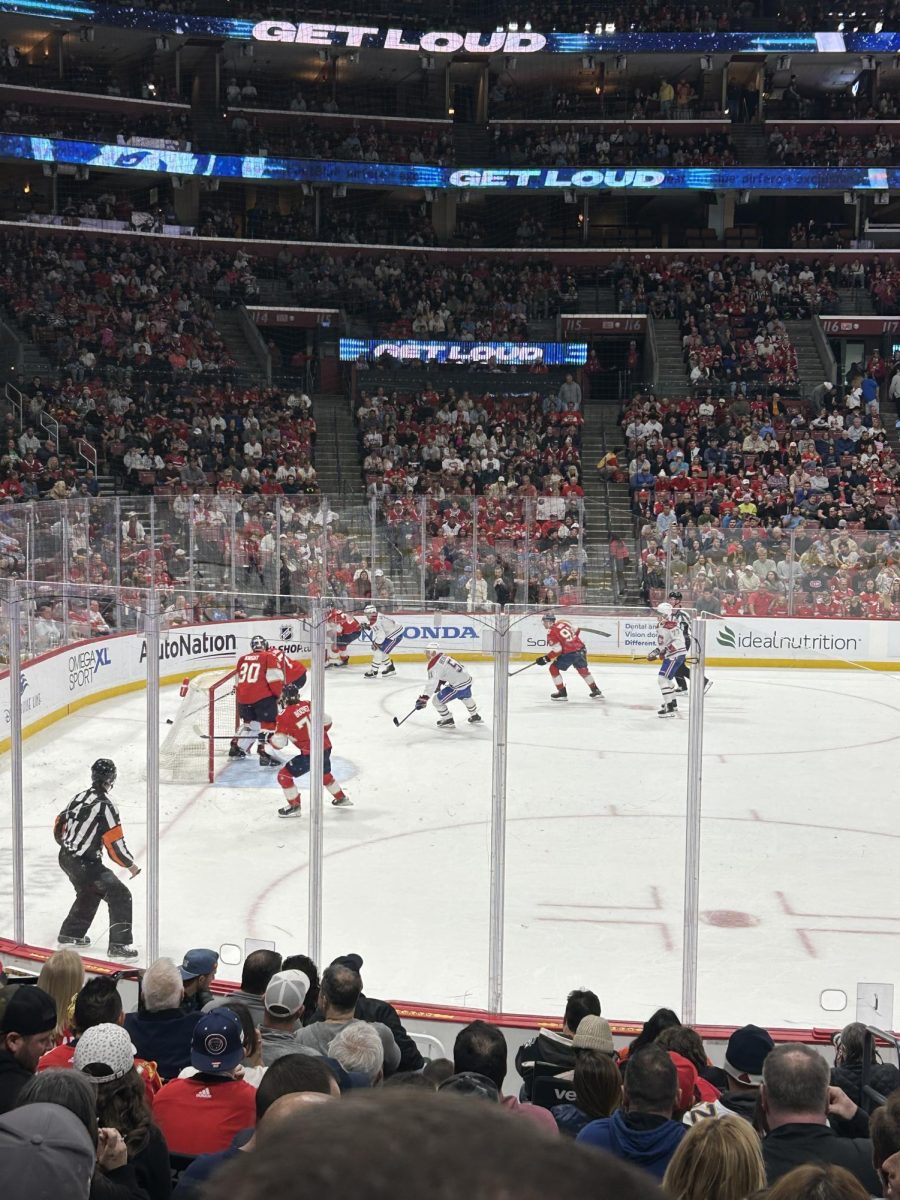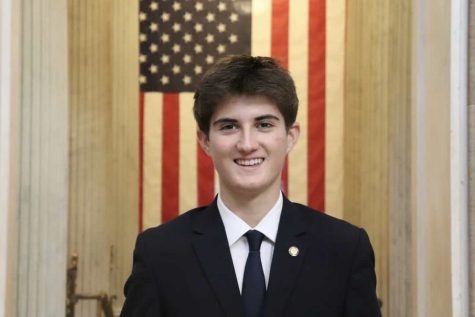A “drone racing world championship” sounds less appealing than pretty much every single professional sporting event to come through Miami-Dade County. Those were my exact thoughts as I sat bitterly in my idling car, waiting for the 12th Avenue Bridge to lower so I could make my way to the Drone Racing League 2023 Algor and World Championship Race at the Miami Marlins’ loanDepot Park.
You can imagine my surprise, then, when I entered the stadium. Almost immediately, I ran face-first into an enveloping wall of sound one would expect to find at an NBA Finals game. As I craned my head to find the source of the ruckus, I gazed upon a truly unexpected sight — almost every single seat in the seating area had been filled. Fans roared and whooped, their enthusiastic shouts forming a deafening cacophony. Attendance was so close to the maximum capacity that Features Editor Emma Dvorkin ‘24 and I, only 30 minutes late, had to comb through the park’s fan sections until we finally found two empty seats in a distant corner.
What sparked all this excitement?
The race, which capped off the 2022-23 Drone Racing League, or DRL, season, promised to bring “the ultimate drone racing party to Miami with celebrity guests, sky-high stunts, and immersive competition,” according to a press release by the league. It had all the trappings of the contemporary tech craze: sponsorship by “the leading high-performance blockchain platform,” Algorand; the opportunity to redeem a free non-fungible token, or NFT, upon arrival; a post-race “drone light show”; a gaming-inspired course complete with slick LED lights and high-speed drone technology; and a DRL-sponsored Snapchat camera filter which placed a fake virtual reality headset and drone on the user’s face.
The event garnered the hearty endorsement of Miami Mayor Francis Suarez and Miami Dolphins wide receiver Tyreek Hill. In the words of Mayor Suarez, who the Drone Racing League named its “Miami Drone Commissioner” (a ludicrous, made-up position), “the Drone Racing League is made for Miami, igniting our city’s passion points of technology, sports and entertainment, and I’m proud to serve as their Miami Drone Commissioner.” Mayor Suarez has been outspoken in his support of the tech industry in Miami, undertaking a relentless campaign to woo technology startups and entrepreneurs to the city. Hill, the NFL’s fastest player and undoubtedly the recipient of an exorbitant payout for his time, completed the tournament’s “First Flight,” flying the fastest drone to officially open the course.
By the time we took our seats, the initial ceremonies and “First Flight” were over, and the first race was about to begin. The drones, which measured less than two feet long, lined up on the left-hand side of the baseball-diamond-turned-drone-obstacle-course, illuminated in vibrant colors by LEDs. A canopy decorated with even more rainbow-colored lights and smoke machines stood in the field’s center. From my nosebleed seats, I barely made out the distant outlines of some humans under that structure. They were slouched on gamer chairs, each adorned with yet another strip of LEDs (which, as you might already be able to tell, were absolutely everywhere). Squinting my eyes, I saw that VR goggles concealed the upper halves of the figures’ faces. Then it dawned on me: these were the drone pilots.
Almost on cue, the stadium’s jumbotron panned across the racers that were preparing to take off. The crowd roared as the pilots appeared on the big screen. The racers fit a common trend: Gen-Z or Millennial, male, and overwhelmingly white.
The VR headsets the racers wore allowed them to see the world from a camera on the drone. This form of drone piloting, called “first-person view,” or FPV, emerged as a sport in 2011, when amateur drone pilots held impromptu races in Karlsruhe, a city in southwestern Germany, using makeshift wooden structures as obstacles for their drones. Since then, it has kept its status as a techy and slightly nerdy pastime. But as drones have gained more mainstream attention, FPV racing has gained an influx of investment and promotion. The Drone Racing League, which calls FPV racing “the sport of the future,” boasts partnerships with hulking corporations like arms manufacturer Lockheed Martin, BMW, Swatch, WWE, and NBC Sports.
DRL also works with the US Military. The US Air Force, one of the DRL’s main partners, brought what it called its ECHO Experience to the tournament, “demonstrating the importance of cognitive abilities in the United States Air Force’s mission through virtual reality,” in the Air Force’s own words. The Experience allows participants to play virtual reality strategy games. This is essentially a recruiting tool – at the end of the session, the results “highlight which Air Force career paths would be viable based on [the participant’s] performance and how they can continue to improve their cognitive skills,” according to a US Air Force press release.
After a NASA-like countdown from the commentators, the machines, which can reach a top speed of 90 mph, whirred their propellers and rapidly accelerated through the tournament’s obstacle course. For the first few seconds of the race, the drones stayed in a pack as they peeled off the starting line simultaneously. Once they hit the first barrier, a neon-green square that the pilots had to thread their drones through, a few pulled ahead. They continued onwards, threading through barriers, weaving in between pillars, and looping under and over small openings. Every one of these obstacles featured very bright strips of – yep, you guessed it – LEDs.
Halfway through the first lap around the course, two drones smacked into each other and fell directly to the ground. The crowd roared, and several attendees in my section leaped to their feet. All the while, the pilots sat slouched in their state-of-the-art gamer chairs, motionless except for their twiddling thumbs.
After one more lap, which featured more collisions with obstacles and other drones, the winner landed in the collection zone, closely followed by the runners-up.
Reaching decibel levels seldom recorded at the loanDepot Park, which usually fields sparse crowds at Marlins home games, the fans let out a thunderous roar. One preteen in the row behind me started screaming the winning racer’s name repeatedly, almost in tears.
Interestingly, most attendees were families with young children. The bright-eyed faces of 8-year-olds donning Fortnite t-shirts dominated the stadium’s “Fan Cam,” starkly contrasting the listless and rueful expressions of their parents, who had reluctantly given up their Saturday nights for this alien spectacle.
Like most people, I’d never seen a drone race before. I had no idea what FPV racing was until a couple of weeks before the tournament took place, when The Catalyst’s faculty sponsor, Dr. Margini, told us we could get free tickets for this event. Coming in with no familiarity with the sport, I found myself pleasantly surprised by how entertaining the first few contests were. The crowd felt electric, and the action during the races captivated me and countless other fans.
Still, after an hour or so, the spectacle started to get repetitive. On the comedown from seeing Tyreek Hill out on the field, and after redeeming their surely worthless NFTs, attendees began staring wearily at their phones. As the rounds, which featured the exact same path around the exact same obstacle course, dragged on, the crowd started to thin. The tournament’s emcee, who to me looked like the epitome of Miami’s tech boom – white, male, mid-30s, and slightly awkward – would periodically ask the crowd to “make some noise” for racers as he addressed the crowd. Each time, the fan response was weaker and weaker. Eventually, his desperate plea for engagement went totally ignored.
To find out why some members of the crowd came, I struck up a few conversations. An older man with grey hair dressed in a polo and khakis said, “it wasn’t bad, especially since I got in for free.” A father in his 30s who accompanied his wife and young son to the event told me his family also got their tickets for no cost. “The school my son goes to sent out this notice saying we could go to this for free, so we thought we’d check it out,” he said as he left the stadium. “It was pretty interesting at the beginning, but it got old. It’s almost [my kid’s] bedtime anyways.” Arjun Badwal ‘23, a Ransom Everglades senior who attended the tournament, heard about the event from Mr. Paul Natland, a physics teacher at RE. He’d never seen a live drone race before but had heard of FPV racing on YouTube. The complementary package Mr. Natland offered to interested students convinced him and his father to go see the event. “I loved it,” he said. “It was super fun, super interesting.”
When I heard these testimonies, I deduced that many, if not most, attendees probably didn’t pay a dime for their tickets. A large portion of these people shared my unfamiliarity with FPV drone racing, never having seen or heard of the sport before either. In my eyes, these revelations made it clear that the interest this event garnered was, to a significant extent, artificial. And for a brand that prides itself on its availability on “YouTube, TikTok, Twitch, Twitter, Instagram and Facebook,” DRL’s content doesn’t seem to reach many people on those platforms. The league’s Instagram Reels and YouTube videos rarely manage over 1000 views. The latest stream on its Twitch channel received only 313 views as of March 7th.
In so many ways, this tournament represents the essence of the tech industry boom the country — and particularly Miami — has witnessed over the last few years. Just like the MiamiCoin, a cryptocurrency that launched in August 2021 to much fanfare from Mayor Suarez and has now tanked in value to less than $0.00033 per coin, the event represents nothing more than glitzy hype with no real substance behind it. It’s a crude attempt to cash in on optimism surrounding the commercial possibilities of drone tech and VR, but there’s simply not enough there right now.
Even more concerningly, the city authorities’ push for a tech-focused, gentrified Miami risks eliminating what, in my eyes, makes this place so special – its diversity, vibrant culture, and authentic charm. We need fewer Brickell high-rises and more affordable housing for outpriced Miamians, or this city might lose what made it such an enchanting place in the first place.
Instead of developing into the revolutionary “sport of the future” DRL promises, FPV racing’s main impact on contemporary society seems to be its ability to funnel tech-interested kids into recruitment operations by the US Air Force. Like so many other tech-craze cash grabs, the sport lacks substance behind its rainbow-LED façade. Maybe ten or twenty years from now I’ll be proven wrong, and millions of people around the world will be paying for their tickets in Bitcoin to see a first-person VR perspective of their favorite drone racer weaving through obstacles. But, until that scenario happens, I’ll leave you with this, dear reader: don’t believe the hype.


